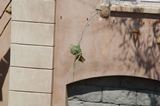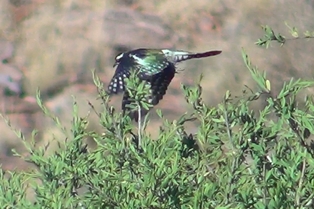Weaver news
| Brown M, Lawes MJ. 2007. Colony size and nest density predict the likelihood of parasitism in the colonial Southern Red Bishop Euplectes orix – Diderick Cuckoo Chrysococcyx caprius system. Ibis 149:321-327 Abstract. Colonial nesters are potentially susceptible to brood parasitism because they present an aggregated source of accessible nests to brood parasites. However, colonial breeding may confer fitness advantages on potential host species that outweigh the costs of parasitism, particularly if colonies are large or dense enough for corporate vigilance to deter parasitism. In addition, some studies have suggested that the spatial habitat structure near host populations is a critical determinant of parasitism rate, with cuckoos targeting those colonies close to cover. We examined the determinants of the likelihood of parasitism by Diderick Cuckoos Chrysococcyx caprius on their main southern African host, the colonially breeding Southern Red Bishop Euplectes orix, from 24 colonies and 1141 nests over two seasons. The likelihood of parasitism by Diderick Cuckoos decreased significantly with increasing colony size and nest density, but not with distance to cover from a colony, providing no support for the spatial habitat structure hypothesis. We suggest that proximate constraints, such as visibility in the semi-closed nest, limit the ability of the host to recognize the Cuckoo egg, giving rise to low rates of rejection of Cuckoo eggs. However, the Cuckoo cannot exploit this apparent weakness when the host breeding population is in large colonies that are protected by corporate vigilance. Consequently, the Diderick Cuckoo – Southern Red Bishop system may represent an evolutionary equilibrium in host and parasite defences.
This study was conducted at 24 Southern Red Bishop colonies (with a total of 1141 nests) over two seasons (December 1996 to February 1997, and December 1998 to February 1999). The colonies were within a 40-km radius of Pietermaritzburg, South Africa. The number of active Southern Red Bishop nests (ie containing eggs or chicks) and the number of territorial Southern Red Bishop males in breeding plumage at the colonies were taken as measures of colony size. The authors also counted all active nests of all weaver species (Cape Weaver, Yellow Weaver and Thick-billed Weaver) within the colony as another measure of colony size. Colony size for Southern Red Bishops varied from 1-150 (mean 26.7, sd 40.9). Eighty-five nests (7.45%) were parasitized by Diderick Cuckoos. Small colonies were parasitized more than large colonies, often with all active nests parasitized in very small colonies and none in large colonies, with an average of 25.6 ± 33.0% (0-100%) nests parasitized overall. Diderick Cuckoos appear to measure colony size as the number of vigilant weaver males (all species) at a colony. The distance to cover and visibility distance within the colony had a relatively weak influence relative to colony size in this study. The critical colony size at which the likelihood of parasitism reached zero (P = 0.005) was 45 active nests, provided neighbouring nests were < 1.5 m apart and the distance to cover was > 40 m. The authors speculated that the reason some bishops nested in small colonies is that they are inexperienced birds, breeding for the first time, and had not been able to secure space in larger colonies. Photo (above): adult Diederick Cuckoo flying from singing perch Literature as featured in Weaver Watch news items |











